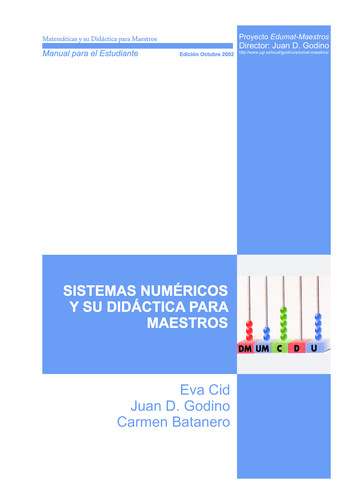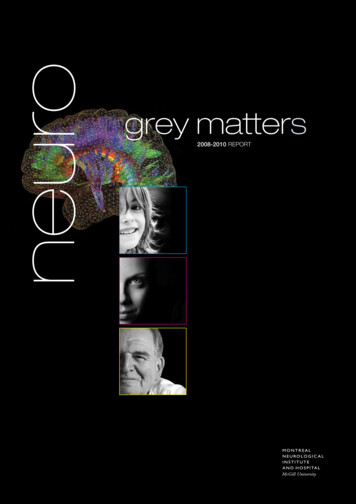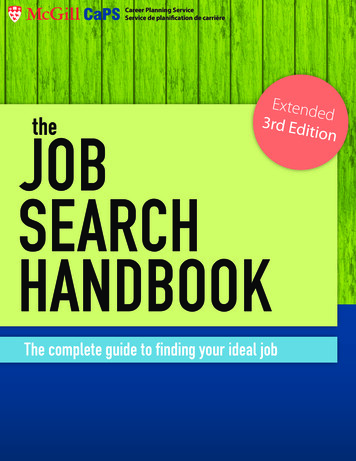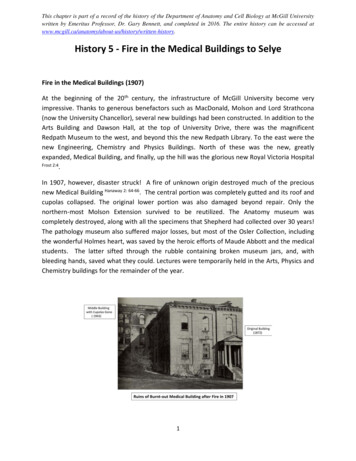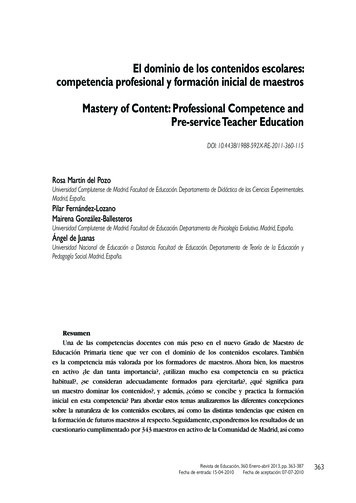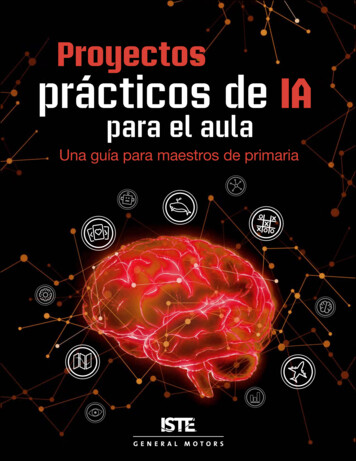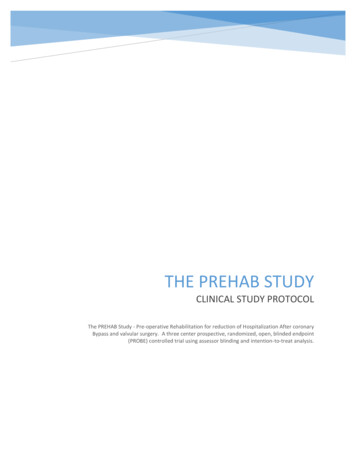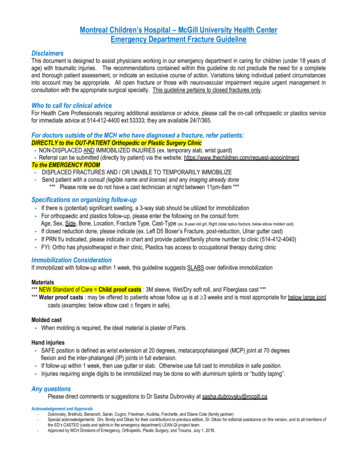
Transcription
¿NiñosMaestros?Environmental education and knowledgetransmission in two rural communities of thePanama Canal WatershedMaude-AlexandréeSt-Denis-MonfilsAnna UsborneFor: Fondo Peregrino-Panamá,McGill University, Envr. 451Prof. Rafael SamundioSupervisors: Marta CurtiKathia HerreraSean DavisApril 27, 2006Fondo Peregrino-Panamá
AcknowledgementsOur sincerest of thanks goes first and foremost to the communities ofSanta Rosa, Guayabalito, and Aguas Claras whose openness andwillingness to help was unfounded and most appreciated. A specialmention goes to the Señora Griselda for her hospitality.Without the continued support from our supervisors Marta Curti, KathiaHerrera and Sean Davis, and all of Fondo Peregrino-Panamá, this projectwould not have been a success. Thank you for your patience andencouragement. Your hard work, enthusiasm and belief in your cause isan inspiration to us both.We also thank our professor Rafael Samudio, our T.A. Bruno Guay andthe program director Catherine Potvin for their academic support andfor presenting us with this opportunity for hands-on, meaningfulresearch. The scholarly and life lessons learned from this project areinvaluable and will be long lasting.Contact InformationA thank you note can be addressed to:Fondo Peregrino-PanamáCuidad del Saber, casa 87Apto. 0844-00230 Paraíso, AncónPanamáTel. (507) 317-0350Fax (507) 317-0064email: fpp@fondoperegrino.orgSean Davis: sdavis@fondoperegrino.orgMarta Curti: mcurti@fondoperegrino.orgKathia Herrera: kherrera@fondoperegrino.orgAnna Usborne: a usborne@hotmail.comMaude-Alexandrée St-Denis Monfils: maudalou@msn.com
Table of Contents1. Executive Summaries . 11.1 Executive Summary English . 11.2 Executive Summary Spanish . 22. Introduction . 42.1 Fondo Peregrino- Panamá. 42.2 Environmental Education 42.3 Past Studies 53. Our Study and Objectives . 73.1 Site Description . 74. Methods . 84.1 Survey #1 94.2 Activities . 94.3 Survey #2 114.4 Analysis 114.5 Ethical Considerations .115. Results 125.1 Knowledge Transmission and Gain . 125.2 Attitudes Towards Environmental Education . 136. Discussion . 146.1 Knowledge Transmission 146.2 Comparison of Communities . 156.3 Local attitudes towards environment and education 166.4 Limitations and Challenges .177. Recommendations to Fondo Peregrino 187.1 To maximize knowledge transmission . 197.2 To maximize community learning . 198. Conclusions . 219. References . 2210. Appendices . 24
Envr. 451M. St-Denis-Monfils, A. Usborne1. Executive Summaries1.1 Executive Summary- English¿Niños Maestros? Environmental education and knowledge transmission in tworural communities of the Panama Canal WatershedMaude-Alexandrée St-Denis-MonfilsAnna UsborneFondo Peregrino-PanamáCuidad del Saber, casa 87Apto. 0844-00230 Paraíso, AncónPanamáFondo Peregrino- Panamá, a branch of The Peregrine Fund U.S.A., is a nongovernmental organization working for the preservation of the endangered Harpy Eagleand for the conservation of eagle habitat in Panama and Central America. As a part oftheir Neotropical Environmental Education Program (NEEP), they also seek to provideraptor and general environmental education to local Panamanians, especially focusing onrural communities situated near Harpy Eagle populations.For Fondo Peregrino, classroom visits are the most popular method of disseminatingeducational material, as school children are a readily available audience. Reaching adultpopulations in rural communities, however, poses larger challenges. Therefore, as analternative to adult presentations, Fondo Peregrino is investigating the possibility oftransmitting knowledge through the children of a community. In this study specifically,we examined whether lessons conducted with school children during several shortclassroom presentations, combined with assignment of a homework exercise that requiredparent participation, was an effective means of transmitting environmental knowledge toadult community members.To identify the presence of intergenerational knowledge transfer, we administeredknowledge-testing surveys to adult residents before and after conducting classroomactivities in one small and one large community in the Panama Canal Watershed.Surveys were administered to both parents and other adults who did not have childrenparticipating in our activities. Opinion-based questions were also included in the surveysfor the purposes of gathering recommendations for improvement of the currentenvironmental education approach in the communities.Survey scores reflected that though there was a significant level of improvement betweenthe first and the second survey, effective learning was minimal. Of the fifty-two adultrespondents only several demonstrated they had concretely learned from a child and fromthe homework exercise given. Adults who were not parents of participants in ouractivities or adults who did not see the homework exercise demonstrated no learning.Both the larger and smaller community generated similar results in our analysis.Results and recommendations gathered indicate that though classroom visits are animportant and locally valued method of environmental education, they are not an1
Envr. 451M. St-Denis-Monfils, A. Usborneeffective means of educating the adult population in general. Adults recognize theimportance of environmental education for their children and for themselves, but withoutmore intensive classroom and homework-based exercises, and without continuededucation initiatives targeted specifically towards adults, they will not effectively learnenvironmental lessons. Therefore, continued efforts on the part of Fondo PeregrinoPanamá need to be made to contact and teach adults in rural communities.1.2 Executive Summary Spanish¿Niños Maestros? Environmental education and knowledge transmission in tworural communities of the Panama Canal WatershedMaude-Alexandrée St-Denis-MonfilsAnna UsborneFondo Peregrino-PanamáCuidad del Saber, casa 87Apto. 0844-00230 Paraíso, AncónPanamáEl Fondo Peregrino-Panamá, una rama del Peregrine Fund U.S.A., es una organizaciónno-gubernamental (ONG) que trabaja por la preservación del Águila Arpía y laconservación de su hábitat en Panamá y Centro América. En su programa de educaciónambiental neotropical (NEEP), el Fondo Peregrino Panamá quiere transmitirconocimientos sobre las rapaces y el ambiente en general, en comunidades rurales cercade poblaciones de Águilas Arpías en Panamá.Para la organización, el método de educación el más popular es de visitar niños en laescuela, porque es una audiencia disponible y fácil de acceso, mientras reunir los adultospor ese tipo de presentación es un desafío más grande. Por lo tanto, como alternativa a laspresentaciones con adultos, Fondo Peregrino está investigando la posibilidad detransmitir conocimientos a través de los niños de una comunidad. En ese estudioespecíficamente, examinamos si lecciones enseñadas a los niños de cuarto, quinto y sextogrado durante algunas presentaciones en la escuela, junto con una tarea que necesita laparticipación de padres, son herramientas eficientes de transmisión de conocimientosambientales a los adultos de una comunidad.Con el objetivo de identificar si existe una transferencia intergeneracional deconocimientos, administramos un sondeo a un adulto de cada casa en dos comunidades,una grande y una pequeña, antes y después de dar clases a los niños. Para recogerrecomendaciones para mejorar el enfoque actual de educación ambiental, los sondeos nosolo evalúan los conocimientos acerca del ambiente, pero también contenían preguntas deopinión.Los resultados de los sondeos mostraron que aunque notemos una mejoría significativaentre la primera y la segunda encuesta, aprendizajes efectivos son mínimos. De loscincuenta y dos adultos que respondieron a nuestros sondeos, solamente algunosdemostraron haber realizados aprendizajes verdaderos a través de los niños o de la tarea.2
Envr. 451M. St-Denis-Monfils, A. UsborneAdultos que no tenían niños presentes a nuestras presentaciones o que no hicieron la tareano demostraron ningún aprendizaje. Las dos comunidades, la pequeña y la grande,generaron resultados similares en nuestro análisis.Los resultados y las recomendaciones hechas consecuentemente, indican que aunque lasvisitas en la escuela sean una herramienta importante y localmente apreciada, no son unamanera eficiente de educar los adultos en general. Los adultos reconocen la importanciade la educación ambiental para sus hijos y para ellos mismo. Sin embargo, másactividades con los niños incluyendo tareas y iniciativas continúas de educación dirigidashacia los adultos serían necesarias para que asimilen eficazmente lecciones ambientales.Por lo tanto, Fondo Peregrino-Panamá necesita continuar sus esfuerzos para enseñar a losadultos en comunidades rurales.3
Envr. 451M. St-Denis-Monfils, A. Usborne2. Introduction2.1 Fondo Peregrino-PanamáFondo Peregrino-Panamá, a branch of the United States based Non GovernmentalOrganization, The Peregrine Fund, works to conserve and promote Harpy Eagle (ÁguilaArpía) populations in Panama through captive breeding and release programs, scientificresearch and environmental education (The Peregrine Fund 2005). The latter goal ofenvironmental education in Panama and other Central American Countries is achievedthrough initiatives of the Neotropical Environmental Education Program (NEEP). Thisprogram was created in 2001 by The Peregrine Fund to work towards their goal to“change human attitudes towards birds of prey, especially Harpy Eagles, to reducepersecution and help conserve their habitat and the biodiversity it contains” (ThePeregrine Fund 2005).Fondo Peregrino-Panamá has been working since 2001 to effectively reach ruralPanamanian communities situated near Harpy Eagle populations. They strive to informthem of the characteristics of the Harpy Eagle and to encourage locals to promote theirconservation, while also attempting to cultivate a sense of pride in the continuedexistence of Panama’s national bird (Fondo Peregrino-Panamá 2005).Beyond solely focusing on the Harpy Eagle, Fondo Peregrino-Panamá has also extendedits vision for education, hoping that through the eagle, information pertaining to generalenvironmental protection and conservation can also be disseminated. A read-aloud guidefor teachers and students entitled “The Nature of Harpy Eagles” has been created, thoughhas not yet been published, which treats the important components of ecosystems andtheir functioning, illustrating general environmental concepts and raptor ecology with theaid of a story of a pair of Harpy Eagles (Curti and Middleton 2005). The goal is for thisguide to reach every primary school in Panama. With initiatives such as the guide, alongwith continued community visits and teacher workshops, Fondo Peregrino-Panamá hopesto improve overall environmental knowledge and awareness in the country (ThePeregrine Fund 2005).2.2 Environmental EducationThe importance of environmental education is paramount in Latin American Countries,which harbour some of the highest biodiversity in the world (Condit et al. 2001). It iswell accepted that environmental education has an essential role in fostering generalscientific knowledge, improving the state of local environments and developingecologically conscientious citizens (Vaughan et al. 1999; Ballantyne et al. 2001; Jenkins2003; Skanavis and Sari 2004; Storey and De Oliveira 2004). In areas where manypeople have not been supplied with formal education opportunities, where they relyheavily on their land for subsistence purposes, and where they live in conjunction withpotentially endangered species, environmental education should be of the utmost priority.4
Envr. 451M. St-Denis-Monfils, A. UsborneEnvironmental education can reach citizens through many different forums, from formalclassroom activities presented by trained education professionals, to informal experienceswith both children and adults conducted in a casual manner. For the purposes of thisstudy the latter form of education will be focused upon, as we as researchers are nottrained educators, nor were the activities created as a part of a larger school curriculum.Non-formal education has several aspects and goals. According to the North AmericanAssociation for Environmental Education’s guidelines for excellence (2005), non formaleducation should: address identified environmental, educational, and community needs,support and complement the parent organization’s goals, and should define and measureresults in order to improve education programs, among others (NAAEE 2006).In addition to the diverse forms environmental education can take, this education can bedisseminated to any number of community groups, from school age children to adults. Adebate continues in the field of environmental education as to the most appropriate targetage group. Some experts state that environmental education must start at an early age, asexperiences as a young child, “play a critical role in shaping life-long attitudes, values,and patterns of behavior toward natural environments”(Wilson 2000). Others, however,argue that adults must be targeted, as they are the ones who construct and enforceenvironmental policy, and at the same time act as role models for their children (Vaughan1999). Fondo Peregrino-Panamá has traditionally focused education initiatives on bothchildren and adults through classroom visits, community outreach programs, andseminars targeted towards adults. They have encountered difficulty, however, inattracting and reaching the adult population, as adults of campesino communities in ruralPanama are rarely able to attend lectures with both work and familial obligations, orchoose not to make the effort to do so (Marta Curti, personal communication).Nevertheless, the rural adult population remains a large demographic with minimalenvironmental knowledge and a maximum potential for altering their environment,especially when considering how their treatment of the Harpy Eagle can have a directimpact on the survival of the species in Central Panama.An alternative to presenting environmental information directly to adults in these ruralcommunities is to attempt to transmit education through their children. This is anattractive option for Fondo Peregrino, as classroom presentations are the most efficientmethod of education for an NGO with limited time, money and personnel. FondoPeregrino staff are unsure, however, how well the information will be transmitted throughthe generations, and how much environmental knowledge, if any, will reach the parentsin a correct form.2.3 Past StudiesFew studies have been conducted on the transmission of knowledge through generationsand communities as a result of childhood environmental education (Vaughan et al. 1999).Through research of existing literature, however, we have identified two examples forfurther examination.5
Envr. 451M. St-Denis-Monfils, A. UsborneIn Queensland, Australia, Ballantyne et al. (2001) suggest that students respond well toinformal environmental education programs and recount interesting portions of sucheducation to their parents, with 73 % of students discussing the program in the home, andjust over half of them bringing home “action” suggestions for improving theenvironment. Educational initiatives were best received when they addressed localenvironmental problems and involved students in field work where they could directlymeasure pollution close to home. The results gathered by Ballantyne et al. (2001)suggest intergenerational transfer is possible, though the study did not directly testknowledge levels before and after the programs through formal testing. They ratherrelied on children and parents to report learning or describe intergenerational encounters,which may not accurately reflect true knowledge transmission. Furthermore, the studywas focused on children from grades 5-12, an older demographic than Fondo-PeregrinoPanamá’s target primary school students, and was conducted in a more affluent area thanrural Panama.An additional study by Vaughan et al. (1999) was conducted in conditions more similarto those found in the Panama Canal Watershed, and promising results were also reported.The program was delivered in a rural Costa Rican community and focused oncharacteristics and conservation issues related to the Scarlet Macaw, an importantenvironmental and economic resource in the area. In total, four, 2-hour classroomsessions were held with third and fourth grade students. The lessons were based on an80-page colouring book that taught Scarlet Macaw natural history and conservationconcepts. Homework consisted of students having to read and colour the books withtheir parents, while also completing question-based worksheets. The answers to thequestions were located within the colouring books. Knowledge levels of students,parents and other community members was tested before, immediately after, and eightmonths after the program. Comparing results of pretests to posttests showed that studentsdemonstrated the most marked increase in learning from the program, improving scoreson 71 % of the questions, but parents also significantly increased their knowledge ofScarlet Macaws, showing improvement on 38 % of questions on the first posttest, and 52% on the posttest eight months later. Interestingly, community members without childrenin the program did not initially improve test scores significantly, but after eight monthselapsed time their scores also increased, suggesting information was eventuallydisseminated beyond the home. This study suggests that intergenerational knowledgetransfer in small, Latin American communities is a distinct possibility. During our study,we will attempt to verify these findings.A final imperative element to any educational program is a portion devoted to evaluation(Bennett 1987; Adams and Tenneson 2004). While our study is mainly focused onidentifying the potential for information transmission, it will also serve the purpose of aqualitative evaluation of educational techniques in the town, and allow us to makesuggestions to Fondo Peregrino on how to most effectively continue education initiativesin rural Panama.6
Envr. 451M. St-Denis-Monfils, A. Usborne3. Our Study and ObjectivesBased on the findings of Ballantyne et al. (2001) and Vaughan et al. (1999) and thenecessity for continued evaluation measures for any ongoing education program, wedesigned a study particular to the needs of Fondo Peregrino in order to assess thetransmission of environmental knowledge from children to adults. Our specificobjectives are:1- To analyze whether information presented in two short classroom presentationsfor primary school children will effectively be transmitted to parents and to otheradults in two rural communities in the Panama Canal Watershed.2- To qualify any differences seen in the effectiveness of knowledge transmission ina smaller as compared to a larger community in the Panama Canal Watershed.3- To use information gathered through surveys, observation and experiences in bothcommunities to formulate recommendations for the continuance of theenvironmental education program of Fondo Peregrino-Panamá.It was our hypothesis that while not all environmental knowledge will be passed from theyounger to the older generation, some information will be disseminated directly toparents while to a lesser extent knowledge will also reach adults who did not havechildren involved in the education activities. Due to the social characteristics of thecommunities where our study took place, we also hypothesized that knowledge will bemore effectively transmitted in the larger community as compared to the smaller, butrecognize this may not be the case for all instances of rural environmental education.3.1 Site Description:Our study will take place in two communities in the Panama Canal Watershed, each ofwhich is located close to the Parque Nacional Soberania (appendix 1). Due to theirproximity to a national conservation area and to populations of Harpy Eagles, educationin the communities is a priority for Fondo Peregrino. Both communities have previouslyhad Fondo Peregrino staff conduct educational workshops with students and interestedadults, thus establishing relations between the community leaders, students and the NGO.Furthermore, McGill students have visited and conducted surveys in the communities inpast years.Community #1: Santa Rosa and GuaybalitoSanta Rosa and Guayabolito is the larger of the two communities. Though it is officiallycomprised of two smaller villages, for social functions, education and communityorganization, they effectively function as one. The two will be hereon referred to asSanta Rosa. The community is located directly on the shores of the Chagres River, and iscomprised of approximately 60 inhabited houses, several small stores selling basicnecessities, two churches, three outdoor “salons” or covered meeting areas, and one7
Envr. 451M. St-Denis-Monfils, A. Usborneprimary school. Houses are located within visual distance of one another with manyextended families situated as neighbours. The majority of citizens practice agriculture asmeans of subsistence, while the second most frequent source of livelihood is salaried jobsoutside of the community (Ghomeshi et al. 2005). Most adults appeared to have a basiclevel of education, either to grade 3 or 6 of primary school, and know how to read andwrite, though older members of the community may not have this ability. A group ofapproximately 20 women, with several key members, form ‘La Asociación de Mujeres deEcoturismo de Santa Rosa y Guaybalito’, which has a strong role in organizing townevents and coordinating individuals. Overall the town seems to have a powerful sense ofcommunity and cooperation, with neighbours frequently interacting with each other, andmany individuals acting as care givers to children.Community #2: Aguas ClarasAguas Claras is the smaller of the two communities and is not located directly on theshores of the Chagres River. It is, however, immediately bordering El Parque NacionalSoberania. Aguas Claras is approximately an hour by road on foot from Santa Rosa. Thecommunity is centered around the public buildings of a small church, school, and publicmeeting house. Approximately 10 dwellings are located nearby, while another 4-6houses are located up to a thirty minute walk from the community center. Thecommunity is more disperse, does not have as many modern amenities (telephone,television, street lights), and does not appear to have the community organization or unityof Santa Rosa. Again, adults appeared to have basic literary skills, though this was notverified, and some elderly community members may not know how to read and write.There is no central association with which Fondo Peregrino maintains contact, but insteadrelies on the school teacher as a general liaison. Most community members here alsopractice agriculture for their livelihood though do not have fields close to their dwellingsdue to their proximity to the national park and several reforestation projects. Severalcommunity members have jobs in the forest plantations while others have temporary orpermanent salaried employment outside of the community (Ghomeshi et al. 2005).4. MethodsIn order to evaluate the possibility of inter-generational transmission of information fromchildren to adults, our project was divided in three major parts. The first was the creationand administration of a preliminary survey to the adults of the communities to evaluatetheir actual knowledge on the subjects we later approached with the children. The secondportion was to conduct classroom activities with children addressing severalenvironmental concepts. The last was to conduct a second survey to evaluate howeffectively knowledge was transferred from the students to their parents and to otheradult members of the community.To determine knowledge gain, ten questions were repeated across the first and the secondsurveys (marked with an asterix in Appendices 2 and 3). The answers for these questionswere later analyzed for improvement of scores. Additional questions were interspersedthroughout the survey in order to put the interviewee at ease, provide variation between8
Envr. 451M. St-Denis-Monfils, A. Usbornethe two surveys, and to gather adult opinions related to the environment and ourenvironmental education initiatives.Our methods were loosely based on those employed by Vaughan et al. (1999), thoughdue to time and logistical constraints, we did not analyze the knowledge gain by studentsin a formal manner. We therefore have made a large assumption that the childreninitially learned the correct information during the classroom activities. Oral verificationduring presentations and communication with students outside the school suggested thatstudents generally learned the material well. Furthermore, we did no long-termevaluation of knowledge gain several months after the activities were conducted as theyhad done in the Costa Rican example.The three portions of our field work are described in detail below:4.1 Survey # 1- Preliminary Evaluation of KnowledgeThe first survey comprised 24 questions that began by addressing parental status,continued with knowledge based inquiries, and finished with several open-ended, opinionbased conversation topics (Appendix 2). Before proceeding to conduct the surveys, apretest was conducted with 6 houses in Santa Clara de Arraijan to verify we, the twoindividual researchers, were presenting the survey in identical fashions, and to verifysurvey clarity. In Santa Rosa, Guayabalito and Aguas Claras we preceded from door todoor in each community, interviewing one adult from each household. A total of 58surveys were conducted in the two communities (48 in Santa Rosa and 10 in AguasClaras) between February 6th and 8th, 2006. Before each survey we provided an informalintroduction, describing the purpose of the survey and the overall project, and asking forvoluntary participation (Appendix 4). Each survey took approximately 10-15 minutes tocomplete depending on the amount of conversation and level of comprehension on thepart of the interviewee. We did not provide correct answers to the questions at this time,nor did we indicate if the respondent had scored well on the knowledge testing questions.During free time in the communities, we attempted to integrate into community activities,meet children and parents, and disseminate information pertaining to why we werepresent.Upon return to Panama City, questions that were to be used for statistical analysis weregraded, and additional comments were noted.4.2 ActivitiesOn March 20th and 21st, 2006 the initial presentations were given to students of AguasClaras and Santa Rosa. The presentations were designed to address students in grades 4,5 and 6, though were presented to all available students. In Aguas Claras the presentationwas delivered within the one room schoolhouse to eight children, grades 1-6, with theteacher present. In Santa Rosa and Guayabalito, due to difficulties with securing teachersfor the school, there were no classes the week of April 20th. Given that this was the only9
Envr. 451M. St-Denis-Monfils, A. Usbornetime for us to present to the students, we informally gathered fifteen local students fromgrades 4, 5 and 6 and taught them the same lesson, but in a more casual manner, in acovered area behind the local store. Both presentations took approximately an hour and ahalf to complete.The presentation given began with an introduction to water, its importance, its phases,and the water cycle. We then addressed issues of water contamination and potentialcontaminants. We concluded by discussing the importance of plants in the ecosystem,mostly stressing concepts of what plants need to live, and in turn, how they help ussurvive. To encourage student participation throughout the presentation, we often askedquestions or conducted demonstrations that required students to be involved. We usedseveral visual aids such as posters, props and the black board to reinforce concepts(Appendix 5). The visual aids we brought were left with the teacher or students when wedeparted. Additionally, we concluded by leaving behind one experiment with thechildren to demonstrate the water cycle, the results of which we analyzed during thesecond visit. Homework was also assigned at the conclusion of the first class.In Aguas Claras only the students in grades 4, 5 and 6 were asked to complete thehomework, while younger students who received the presentation were simply asked tocolour the pictures (Appendix 6). All students were assigned the homework in SantaRosa. The homework consisted of both information and questions for completion. Theanswers to the questions could either be found within the homework itself, or had beensupplied during the presentation. Activities within the homework all asked for adultparticipation, either by asking the student to interview an adult, to tell an adult a story, orto explain a concept to an adult. In class we also emphasized the importance ofcompleting the homework with a parent, older sibling or another adult member of thecommunity.On Friday, April 25th, we returned to both Aguas Claras and Santa Rosa to meet with thestudents once again, correct the homework, reinforce concepts covered, verify results ofthe experiment, and g
El Fondo Peregrino-Panamá, una rama del Peregrine Fund U.S.A., es una organización no-gubernamental (ONG) que trabaja por la preservación del Águila Arpía y la conservación de su hábitat en Panamá y Centro América. En su programa de educación ambiental neotropical (NEEP), el Fondo Peregrino Panamá quiere transmitir
